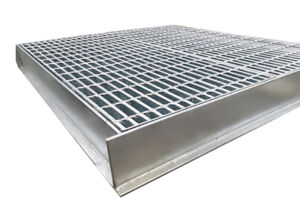Heavy duty grating for large machinery platforms is an essential component in various industrial applications. These gratings are designed to support heavy loads while providing durability and safety. When selecting heavy duty grating, it is crucial to consider factors such as material, load capacity, and environmental conditions.
The primary materials used for heavy duty grating include steel, aluminio, and fiberglass. Steel grating is known for its strength and toughness, making it suitable for the most demanding environments. Aluminum, on the other hand, offers lightweight properties and corrosion resistance, ideal for applications where weight is a concern.
Fiberglass reinforced plastic (FRP) grating is another popular option due to its non-corrosive nature and low maintenance requirements. Each material has its advantages, and the choice often depends on the specific needs of the machinery platform and the environment in which it operates.
Load capacity is a critical factor when choosing heavy duty grating for large machinery platforms. It is essential to assess the weight of the machinery and any potential dynamic loads that may occur during operation. Manufacturers often provide load tables that help in determining the appropriate grating type for specific applications.
Environmental conditions, such as exposure to chemicals, moisture, and temperature fluctuations, can significantly impact the performance of heavy duty grating. For example, areas with high humidity or corrosive substances may require specialized coatings or materials to ensure longevity and safety.
Installation of heavy duty grating is another important consideration. Proper installation techniques are vital to ensure that the grating can support the intended loads and withstand environmental stresses. It is often recommended to follow the manufacturer’s guidelines for installation to achieve optimal performance.
Maintenance of heavy duty grating should not be overlooked. Regular inspections and cleaning can help to identify potential issues before they become significant problems. This proactive approach can extend the lifespan of the grating and enhance the safety of the machinery platform.
In addition to load capacity and environmental factors, the design of heavy duty grating can also impact its performance. Various designs, such as welded or swaged, offer different benefits and should be considered based on the specific application requirements.
Safety is paramount when dealing with large machinery platforms. Heavy duty grating provides a slip-resistant surface that enhances safety for personnel working in these environments. This feature is particularly important in wet or oily conditions where slips and falls can occur.
The versatility of heavy duty grating makes it suitable for various applications, including industrial plants, warehouses, and outdoor platforms. Its ability to support heavy machinery while providing a safe working environment is why it is a preferred choice among engineers and facility managers.

Another benefit of heavy duty grating is its ease of customization. Many manufacturers offer bespoke solutions to meet specific requirements, ensuring that the grating fits perfectly within the designated space and meets load specifications.
When considering heavy duty grating for large machinery platforms, it is also important to evaluate the cost-effectiveness of different options. While some materials may have a higher upfront cost, their durability and low maintenance needs can lead to long-term savings.
The installation process can vary depending on the type of heavy duty grating chosen. For instance, steel grating may require welding or bolting, while fiberglass grating can often be installed using simpler fastening methods. Understanding these differences can help in planning the installation phase effectively.
In terms of aesthetics, heavy duty grating can be designed to blend in with the surrounding environment or stand out as a safety feature. The choice of color and finish can influence the overall appearance of the machinery platform, making it more visually appealing.
Heavy duty grating is not only functional but also contributes to the overall efficiency of a machinery platform. By providing a stable and durable surface, it allows for the smooth operation of equipment and can enhance productivity.
Furthermore, the use of heavy duty grating can help in meeting regulatory compliance and safety standards. Many industries have specific requirements for flooring and platforms, and using the right type of grating can help organizations adhere to these regulations.
As technology advances, so does the manufacturing process of heavy duty grating. Innovations in materials and design are continually improving the performance and safety features of these products, making them even more reliable for industrial applications.
The global market for heavy duty grating is expected to grow, driven by the increasing demand for industrial infrastructure and safety solutions. As industries expand, the need for robust and safe machinery platforms will continue to rise.
When selecting a supplier for heavy duty grating, it is essential to choose a reputable manufacturer with a track record of quality and reliability. Reading customer reviews and requesting samples can help in making an informed decision.
In conclusion, heavy duty grating for large machinery platforms is a critical component that ensures safety, efficiency, and durability. By understanding the various factors involved in selecting the right grating, businesses can enhance the performance of their machinery platforms and contribute to a safer working environment.
Overall, investing in high-quality heavy duty grating is a decision that pays off in the long run. Whether for new installations or retrofitting existing platforms, the right grating solution can make a significant difference in operational success.

